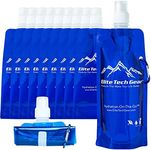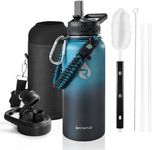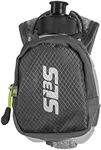Buying Guide for the Best Cold Water Bottles
Choosing the right cold-water bottle can make a significant difference in your daily hydration routine. Whether you're an athlete, a hiker, or someone who just wants to stay hydrated throughout the day, there are several key specifications to consider. Understanding these specs will help you select a bottle that best fits your needs and lifestyle.MaterialThe material of a cold-water bottle is crucial as it affects durability, weight, and insulation properties. Common materials include stainless steel, plastic, and glass. Stainless steel bottles are highly durable and offer excellent insulation, keeping your water cold for longer periods. Plastic bottles are lightweight and often more affordable, but they may not keep water cold as long. Glass bottles are great for those who prefer a clean taste and are environmentally friendly, but they can be heavier and more fragile. Choose a material based on your need for durability, insulation, and weight.
InsulationInsulation is what keeps your water cold for extended periods. There are single-wall and double-wall insulated bottles. Single-wall bottles are not insulated and are best for short-term use. Double-wall insulated bottles have a vacuum layer that prevents heat transfer, keeping your water cold for up to 24 hours or more. If you need your water to stay cold for long periods, such as during a hike or a long day out, opt for a double-wall insulated bottle.
CapacityCapacity refers to how much water the bottle can hold, typically measured in ounces or liters. Smaller bottles (12-18 ounces) are portable and fit easily in bags, making them ideal for short outings or gym sessions. Medium-sized bottles (20-32 ounces) offer a good balance between portability and capacity, suitable for daily use. Larger bottles (40 ounces and above) are great for long trips or when you need to stay hydrated for extended periods without refilling. Choose a capacity based on how much water you need to carry and how often you can refill it.
Lid TypeThe lid type affects both convenience and functionality. Common lid types include screw-on, flip-top, and straw lids. Screw-on lids are secure and prevent leaks, making them ideal for travel. Flip-top lids offer quick access and are great for one-handed use, perfect for athletes. Straw lids allow you to drink without tilting the bottle, which is convenient for driving or multitasking. Consider how and where you'll be using the bottle to choose the most suitable lid type.
Ease of CleaningEase of cleaning is important for maintaining hygiene and the longevity of your bottle. Bottles with wide mouths are easier to clean and can accommodate ice cubes, but they may be prone to spills. Narrow-mouth bottles are less likely to spill but can be harder to clean. Some bottles are dishwasher safe, which can save time and effort. If you plan to use your bottle frequently, choose one that is easy to clean to ensure it remains hygienic.
DurabilityDurability is a measure of how well the bottle can withstand drops, impacts, and general wear and tear. Stainless steel bottles are typically the most durable, followed by high-quality plastic bottles. Glass bottles are the least durable but can be protected with silicone sleeves. If you lead an active lifestyle or plan to use the bottle in rugged conditions, opt for a more durable material to ensure it lasts longer.
Design and AestheticsWhile functionality is key, the design and aesthetics of a water bottle can also be important. Some bottles come in a variety of colors, patterns, and finishes, allowing you to choose one that matches your personal style. Additionally, ergonomic designs can make the bottle more comfortable to hold and use. If appearance and comfort are important to you, consider these factors when making your choice.





















